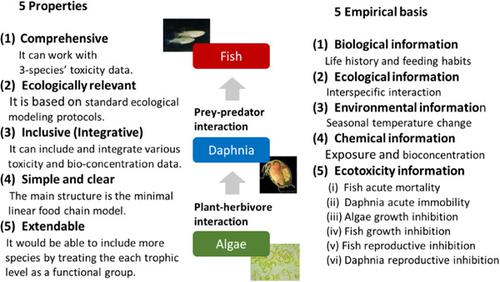当前位置:
X-MOL 学术
›
Environ. Toxicol. Chem.
›
论文详情
Our official English website, www.x-mol.net, welcomes your
feedback! (Note: you will need to create a separate account there.)
A 3-Species Aquatic Community Model for Ecological Risk Assessment Using Basic Ecotoxicity Data.
Environmental Toxicology and Chemistry ( IF 3.6 ) Pub Date : 2020-04-15 , DOI: 10.1002/etc.4700 Yoshinari Tanaka 1 , Shigeto Oda 1 , Kensei Nakamura 1 , Noriyuki Suzuki 1
Environmental Toxicology and Chemistry ( IF 3.6 ) Pub Date : 2020-04-15 , DOI: 10.1002/etc.4700 Yoshinari Tanaka 1 , Shigeto Oda 1 , Kensei Nakamura 1 , Noriyuki Suzuki 1
Affiliation

|
A simplified ecosystem model, the Aquatic Tritrophic Ecological Risk Assessment Model (A-TERAM), for the ecological risk assessment of chemicals is presented. The A-TERAM comprises a linear grazer food chain with 3 trophic levels (the algae-Daphnia-fish system). The model simulates the seasonal patterns of abundance at each level observed in the field, and it translates the direct toxic effects of chemicals on algae or Daphnia to implications for fish via ecological interactions; thus, the A-TERAM evaluates ecological risk in terms of the annual population growth rate of fish. The model also incorporates toxicokinetics for fish. The minimum input data required for the A-TERAM are basic ecotoxicity endpoints (algal growth inhibition median effect concentration [EC50] or no-observed effect concentration, Daphnia immobility EC50, and fish acute mortality median lethal concentration); however, additional ecotoxicity data (Daphnia reproduction test, fish early life test, and fish reproduction test) are also relevant for improving simulations. Comparisons made across 496 chemicals (255 nonagricultural chemicals and 241 agrochemicals) indicated that the A-TERAM, in comparison with the conventional predicted-effect concentration/predicted-no-effect concentration method, tended to evaluate higher risk to chemicals that are highly bioaccumulative and toxic to fish by 2 orders of magnitude at the largest but lower or comparable risk to chemicals that are toxic only to algae or Daphnia. Environ Toxicol Chem 2020;39:1086-1100. © 2020 SETAC.
中文翻译:

使用基本生态毒性数据进行生态风险评估的3种水生群落模型。
提出了一种简化的生态系统模型,即水生三养生态风险评估模型(A-TERAM),用于化学物质的生态风险评估。A-TERAM包含具有3个营养水平的线性放牧者食物链(藻类-水蚤-鱼类系统)。该模型模拟了在田间观察到的每个水平上的丰度季节性模式,并将化学物质对藻类或水蚤的直接毒性作用转化为通过生态相互作用对鱼类的影响;因此,A-TERAM根据鱼类的年增长率来评估生态风险。该模型还包含了鱼的毒物动力学。A-TERAM所需的最低输入数据是基本的生态毒性终点(藻类生长抑制中值作用浓度[EC50]或未观察到的作用浓度,水蚤固定EC50,和鱼类急性死亡率中值致死浓度);但是,其他生态毒性数据(水蚤繁殖测试,鱼类早期寿命测试和鱼类繁殖测试)也与改进模拟有关。对496种化学品(255种非农用化学品和241种农用化学品)进行的比较表明,与传统的预测影响浓度/预测无影响浓度方法相比,A-TERAM倾向于评估具有高生物累积性的化学品的较高风险。对鱼类的毒性最大,但对仅对藻类或水蚤有毒的化学物质的风险降低了两个数量级。Environ Toxicol Chem 2020; 39:1086-1100。©2020 SETAC。和鱼类繁殖测试)也与改善模拟效果相关。对496种化学品(255种非农用化学品和241种农用化学品)进行的比较表明,与传统的预测影响浓度/预测无影响浓度方法相比,A-TERAM倾向于评估具有高生物蓄积性的化学品的较高风险。对鱼类的毒性最大,但对仅对藻类或水蚤有毒的化学物质的风险降低了两个数量级。Environ Toxicol Chem 2020; 39:1086-1100。©2020 SETAC。和鱼类繁殖测试)也与改善模拟效果相关。对496种化学品(255种非农用化学品和241种农用化学品)进行的比较表明,与传统的预测影响浓度/预测无影响浓度方法相比,A-TERAM倾向于评估具有高生物蓄积性的化学品的较高风险。对鱼类的毒性最大,但对仅对藻类或水蚤有毒的化学物质的风险降低了两个数量级。Environ Toxicol Chem 2020; 39:1086-1100。©2020 SETAC。倾向于评估具有高生物蓄积性和对鱼类有毒的化学品的危险性最高,最大的是2个数量级,而对于仅对藻类或水蚤有毒的化学品的危险性较低或相当。Environ Toxicol Chem 2020; 39:1086-1100。©2020 SETAC。倾向于对具有高生物蓄积性和对鱼类有毒性的化学物质的最大风险进行评估,即最大程度降低2个数量级,但对仅对藻类或水蚤有毒的化学物质的风险较低或具有可比性。Environ Toxicol Chem 2020; 39:1086-1100。©2020 SETAC。
更新日期:2020-04-15
中文翻译:

使用基本生态毒性数据进行生态风险评估的3种水生群落模型。
提出了一种简化的生态系统模型,即水生三养生态风险评估模型(A-TERAM),用于化学物质的生态风险评估。A-TERAM包含具有3个营养水平的线性放牧者食物链(藻类-水蚤-鱼类系统)。该模型模拟了在田间观察到的每个水平上的丰度季节性模式,并将化学物质对藻类或水蚤的直接毒性作用转化为通过生态相互作用对鱼类的影响;因此,A-TERAM根据鱼类的年增长率来评估生态风险。该模型还包含了鱼的毒物动力学。A-TERAM所需的最低输入数据是基本的生态毒性终点(藻类生长抑制中值作用浓度[EC50]或未观察到的作用浓度,水蚤固定EC50,和鱼类急性死亡率中值致死浓度);但是,其他生态毒性数据(水蚤繁殖测试,鱼类早期寿命测试和鱼类繁殖测试)也与改进模拟有关。对496种化学品(255种非农用化学品和241种农用化学品)进行的比较表明,与传统的预测影响浓度/预测无影响浓度方法相比,A-TERAM倾向于评估具有高生物累积性的化学品的较高风险。对鱼类的毒性最大,但对仅对藻类或水蚤有毒的化学物质的风险降低了两个数量级。Environ Toxicol Chem 2020; 39:1086-1100。©2020 SETAC。和鱼类繁殖测试)也与改善模拟效果相关。对496种化学品(255种非农用化学品和241种农用化学品)进行的比较表明,与传统的预测影响浓度/预测无影响浓度方法相比,A-TERAM倾向于评估具有高生物蓄积性的化学品的较高风险。对鱼类的毒性最大,但对仅对藻类或水蚤有毒的化学物质的风险降低了两个数量级。Environ Toxicol Chem 2020; 39:1086-1100。©2020 SETAC。和鱼类繁殖测试)也与改善模拟效果相关。对496种化学品(255种非农用化学品和241种农用化学品)进行的比较表明,与传统的预测影响浓度/预测无影响浓度方法相比,A-TERAM倾向于评估具有高生物蓄积性的化学品的较高风险。对鱼类的毒性最大,但对仅对藻类或水蚤有毒的化学物质的风险降低了两个数量级。Environ Toxicol Chem 2020; 39:1086-1100。©2020 SETAC。倾向于评估具有高生物蓄积性和对鱼类有毒的化学品的危险性最高,最大的是2个数量级,而对于仅对藻类或水蚤有毒的化学品的危险性较低或相当。Environ Toxicol Chem 2020; 39:1086-1100。©2020 SETAC。倾向于对具有高生物蓄积性和对鱼类有毒性的化学物质的最大风险进行评估,即最大程度降低2个数量级,但对仅对藻类或水蚤有毒的化学物质的风险较低或具有可比性。Environ Toxicol Chem 2020; 39:1086-1100。©2020 SETAC。











































 京公网安备 11010802027423号
京公网安备 11010802027423号